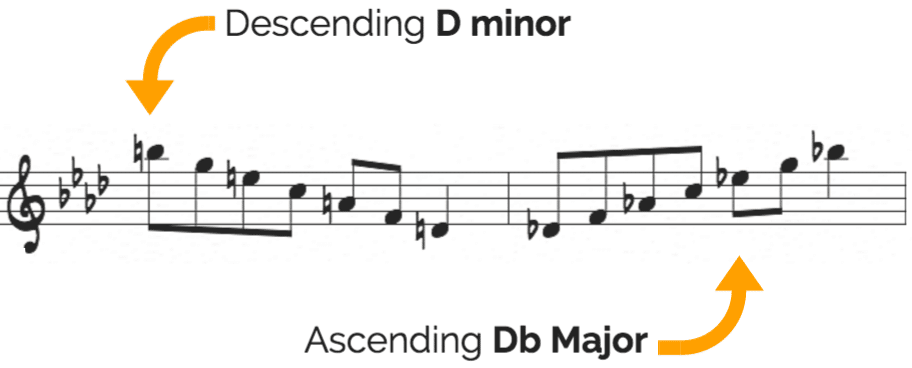Herbie Hancock is one of the greatest living improvisers. From his work with the great Miles Davis Quintet to his own musical explorations, he has spent decades evolving and pushing musical boundaries. But the thing that stands out most is his ability to craft a musical moment for the listener. To transport them out of their daily routine and expectations and into the music itself.
This is the mark of a master musician in any style of music. The ability to create magic with the simplest of tools – rhythm, harmony and melodic statements.
Transcending the details of notes and scales to create a musical message on the spot. And this is a skill that you should start thinking about in your own playing.
For the best players, every solo is an opportunity to create a new musical idea. To make a statement, to interact with other musicians, and to see where the music will go in that split-second…
Remember, not every solo has to be full of double time lines, memorized licks, and theory devices. The secret of a great solo lies creating music in the moment.
Herbie Hancock’s solo on Ceora:
A masterful example of this concept is Herbie Hancock’s solo on Ceora from the Lee Morgan album Cornbread.
Take a listen below (the solo starts at 4:05):
The chord progression to the tune is relatively simple – 32 bars in the key of Ab…
You’ll find ii-V’s to the I chord and the IV chord:
…and more ii-V’s and turnarounds as the form continues:
Hundreds of jazz standards share this same chord progression – major chords, minor chords, ii-V’s and turnarounds. So what do you play over a tune like this?
Most players immediately go to their licks – the ii-V lines that they’ve learned and practice – and cut and paste them right into their solo.
But is that really improvising?
How exactly do you create an original solo over this tune…one that’s unique from every other solo you play?
You must start by looking to your favorite players for inspiration. And that’s exactly why we’ve chosen Herbie Hancock for a lesson in how to develop a melodic solo in a creative way.
Take one more listen to his solo on Ceora, and this time keep your ears open for how he utilizes:
- Rhythmic sequences
- Harmonic themes
- Intervallic patterns
- The shape of the lines
Below we’ll take a closer look at how Herbie Hancock creates 5 distinct musical themes over this common chord progression…
Theme #1: Making a melodic statement
Herbie begins his solo with a simple six note theme:
A musical statement that’s defined by a chromatic approach note, a clear melodic shape, and a definitive rhythm. Now listen to how he develops this theme throughout the first eight bars of the progression:
He continues the line through three different keys, using the rhythm and shape of the theme as the glue that holds everything together. The result is a logical and musical line that the listener can easily follow, a musical story that unfolds piece by piece.
As you look to your own playing, aim to start your solos in this fashion – with a melodic statement instead of your go-to licks. Challenge yourself to keep this original melodic idea going throughout the chord progression.
Theme #2: Rhythmic continuity
In his next phrase, Herbie continues with a theme that is based on one rhythm:
In this line you can hear how he uses a dotted quarter eighth rhythm to play through a ii-V. He emphasizes strong chord tones on the dotted quarter and uses the eighths as passing tones.
This is a great exercise to break free from your usual approach to standard progressions. Start by choosing a rhythm – it’s best to start with a simple rhythmic idea that you’ll be able to develop.
Then try to create musical line utilizing this rhythm, aiming for chord tones while using passing tones and approach notes.
Theme #3: Emphasizing a harmonic color
In his third melodic theme, Herbie plays an arpeggiated line that continues through a ii-V in two keys:
Note how he utilizes the harmonic color of the 13th on each chord in this line, emphasizing each note:
And listen to how he continues the same phrase, but this time focus on the shape of the line:
Here he navigates a sequence of ii-V’s with an arpeggiated line starting and ending on the 13th. If you look at the skeleton of this line, he is using a descending D minor arpeggio and ascending up a Db major to the 13th:
In both cases, he is thinking of the entire ii-V as the minor chord: D minor for D- G7 and Bb minor for Bb- Eb7.
Theme #4: Tritone substitution
As he starts the second 16 bars of his solo, Herbie plays a sequence that utilizes tritone substitution of the V7 chords.
Check out the line below:
Over each V7 chord he applies a descending second inversion triad ( based on the tritone) that resolves to the 5th of the I chord (A triad over Eb7 and D triad over Ab7):
Note how he’s not only using the tritone subs as a harmonic tool, but using them melodically as well.
Theme #5: Developing a theme through a progression
One of the challenges of creating melodic ideas in your solo is being able to sustain the idea through changing harmonies and chord progressions.
In the line below, note how Herbie alters the melody he plays in the first bar to accommodate the changing chord progression:
He begins with a three note theme over the Bb-7 chord and repeats it over the Eb7. In the next two measures however, he alters it, emphasizing the Gb as the b5 on the C-7 b5 and the b9 on the F7 chord.
Aim to use this technique as you develop melodic ideas in your own solos, altering notes by either half-step or whole-step to accommodate the changing harmony.
Start improvising…
Improvising a solo isn’t just inserting the licks and lines that you’ve perfected in the practice room.
It’s taking all of that musical knowledge and creating something new with it in the moment…
Like Herbie did in the solo above, aim to improvise with a musical idea instead of a worked out lick or line. You might have a rhythm in mind or a shape or intervallic theme. Maybe you want to highlight the color of the 13th or use tritone substitution over ii-V’s…
It’s up to you!
As you solo, strive to develop your idea through the harmony and alter it based on the chord progression or what the musicians around you are playing.
As you can see from this solo over Ceora, your ideas don’t have to be complex or slick double-time lines – they just has to be musical and tell a story. Do this and you’ll have a solo that everyone will want to listen to.























